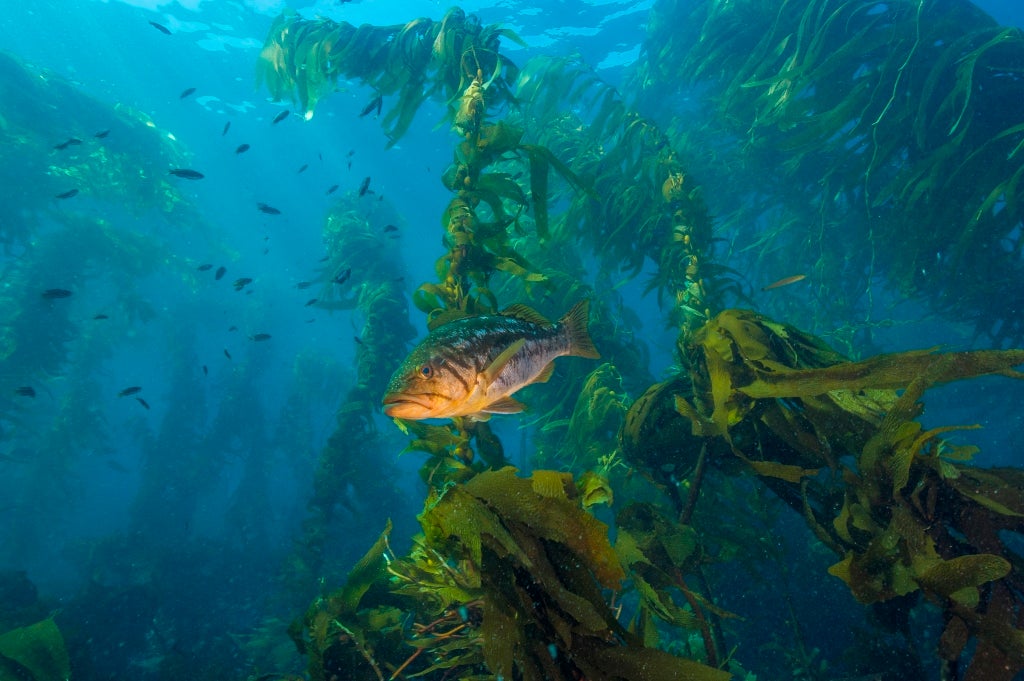Kelp forests thriving in some locations despite environmental stressors, Stanford researcher finds
In a global survey of kelp forests, scientists found that some populations are remaining stable or increasing despite global climate change in part due to local management of stressors such as pollution, fishing and coastal development.
Amid the drumbeat of gloomy climate change news, a reason for hope sways beneath ocean waves.

New research shows that while global factors associated with climate change are generally harming kelp, local management can play a major role in species survival by easing damage from pollution and coastal development. (Image credit: Susanna Pershern)
Kelp forests, the graceful green ecosystems that provide billions of dollars worth of services such as fish feeding grounds and coastal storm protection, are doing surprisingly well in many places, according to a first-ever global analysis of their abundance coauthored by Fiorenza Micheli, the David and Lucile Packard Professor of Marine Science at Stanford. However, an even greater percentage are declining.
While global factors associated with climate change are generally harming kelp, these effects vary by region depending on kelp species, local conditions and other sources of stress. As a result, some kelp forests are staying stable or even increasing, according to the research by an international team of scientists. This indicates that, despite negative effects of climate change, local management can play a major role in species survival by easing damage from impacts such as fishing, pollution and coastal development.
“There is a sense that local efforts to protect and recover ecosystems are futile in the face of global environmental change,” said Micheli, who is also a professor of biology. “Our findings show that local drivers of kelp forest decline can combine with and exacerbate the effects of global drivers, or even outweigh them in some cases. So, local management can be effective in maintaining or recovering these diverse and valuable ecosystems.”
The study, to be published Nov. 14 in Proceedings of the National Academy of Sciences, reports that while kelp in 38 percent of the regions analyzed show clear declines, 27 percent show increases and 35 percent show no net change. This is a different story from that of many other species, such as corals and seagrasses, which have seen global declines.
The difference is in part due to the unique capacity of kelp to recover quickly from disturbances. It also likely reflects large regional differences in the drivers of local environmental change.
Regions in which the researchers documented declines were often those experiencing multiple local stressors such as fishing and global stressors such as climate change. Where they found kelp increases they often found stories of successful local management. For example, kelp forest increases off the coast of Vancouver Island and a stretch of Southern California seem due to local efforts to recover populations of previously exploited predators of sea urchins – major kelp consumers – and reductions in local pollution levels.
The study analyzed trends in kelp abundances from 1,138 sites monitored over the past half-century. However, the researchers point out a “noticeable lack” of baseline data in many regions against which to measure change due in large part to variable and unpredictable research funding. “It is becoming increasingly difficult to maintain monitoring of the coastal marine environment, but it is more important than ever that we keep the pulse of marine ecosystems in the face of mounting global and local stress,” Micheli said.
Micheli is a senior fellow at the Stanford Woods Institute for the Environment. She works out of Stanford’s Hopkins Marine Station.
The research was funded by the National Center for Ecological Analysis and Synthesis.
Julie Cohen, science writer at the University of California, Santa Barbara, contributed to this story.
